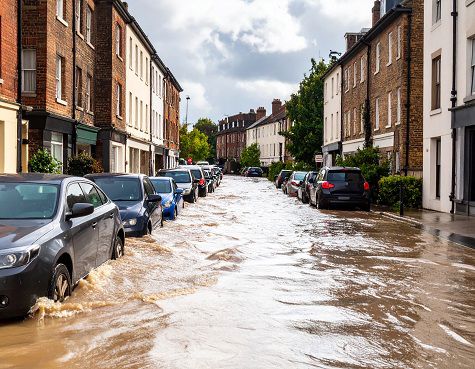Flash flooding hits UK cities
In recent years, cities such as London, Birmingham, and Glasgow have faced increasingly severe flash floods, highlighting a growing vulnerability in the UK’s urban landscape. One striking example occurred in July 2021, when parts of London were inundated with more than a month’s worth of rain in just a few hours, flooding homes, underground stations, and even hospitals.
What is flash flooding?
Flash flooding refers to sudden, intense flooding that occurs within six hours of heavy rainfall. Unlike river flooding, which builds up over days, flash floods strike quickly and with little warning. In urban environments, where concrete and tarmac dominate, rainwater has nowhere to go, overwhelming drainage systems and turning streets into rivers in minutes.
Why is it getting worse?
The growing threat of flash flooding in UK cities is being fuelled by a combination of environmental, structural, and societal pressures, each compounding the other to create a perfect storm for urban flood risk.
One of the most significant drivers is climate change. As global temperatures rise, the atmosphere can hold more moisture, resulting in heavier and more intense rainfall. These sudden downpours are becoming increasingly common during the UK summer, often overwhelming drainage systems that were never designed to cope with such extremes.
Urbanisation is another major factor. As towns and cities continue to expand, natural landscapes like grasslands, wetlands, and woodlands, which would typically absorb rainwater, are being replaced with impermeable surfaces such as concrete, asphalt, and paving. This drastically reduces the land’s ability to soak up water, causing it to run off rapidly into streets and drainage systems, increasing the likelihood of flash floods.
Adding to the challenge is the UK’s aging drainage infrastructure. Much of the urban drainage network was built decades ago and is ill-equipped to handle the volume and intensity of rainfall associated with today’s extreme weather events. In many areas, even moderate storms can overwhelm outdated systems, leading to localised flooding and significant disruption.
The risk of basement properties flooding is on the rise
One particularly vulnerable area is basement-level properties, which are at heightened risk of flooding during flash flood events. Water can accumulate quickly in low-lying spaces, causing extensive damage and posing serious safety risks.
To help property owners and managers prepare, we've developed a short briefing:
Reducing Flood Exposure in Basement Properties: A Strategic Approach
This guide outlines practical steps to improve resilience, limit damage, and reduce insurance exposure. It covers:
- Current insurer responses to flood risk in basements
- Why damage in these areas is especially costly
- Practical steps for preparing a flood response plan
- Preventative actions to reduce exposure and disruption.
Whether you occupy, manage, or insure buildings with basement levels, this guide offers clear, actionable insight into mitigating flood-related loss and supporting smoother claims outcomes.






